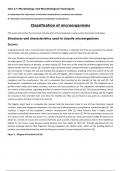Essay
BTEC Applied Science Unit 17AB - Classifying microorganisms (Distinction)
- Course
- Institution
- Book
Exemplar assignment for Unit 17AB, the first assignment in BTEC Applied Science Unit 17, which is about the different methods that you can use to classify pathogens (bacteria, viruses, fungi, protozoa). This assignment contains all the criteria and was given a DISTINCTION. If you take anything fro...
[Show more]




